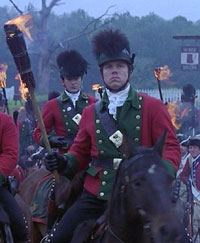影片對白 Harry,
they're not soldiers, they're farmers. They'd be better off letting the British
just march through.
電影故事 The
Patriot 愛國者:創作花絮
考考你
現學現賣
4. Better off
"最好……,比……富裕"的意思,例如:
They were better off flying than driving there.
他們最好坐飛機而不是駕車去那兒。
They were better off than most of their neighbors.
他們比大部分的鄰居日子過得富裕。
當表示"比……富裕"時,better off 的意思就相當于 well off。
文化面面觀
Red coat :英國士兵的紅制服
Red coat is a term often used to refer to a soldier of the historical British
Army because of the color of the uniforms formerly worn by the majority of
regiments. The uniform of most British soldiers during the late 17th century,
18th century and 19th century, (other than artillery, rifles and some cavalry),
included a madder red coat or coatee. From 1872 onwards, the more vivid shade of
scarlet was adopted for all ranks, having previously been worn only by officers,
sergeants and cavalry troopers.
 In the United States, "Redcoat" is particularly associated with those British
soldiers who fought against the colonists during the American Revolution. It
does not appear to have been a contemporary expression - accounts of the time
usually refer to "regulars" or "the King's men". Abusive nicknames included
"bloody backs" (in a reference to both the colour of their coats and the use of
flogging as a means of punishment for military offences) and "lobsters" or
"lobsterbacks" (most notably in Boston around the time of the Boston Massacre).
In the United States, "Redcoat" is particularly associated with those British
soldiers who fought against the colonists during the American Revolution. It
does not appear to have been a contemporary expression - accounts of the time
usually refer to "regulars" or "the King's men". Abusive nicknames included
"bloody backs" (in a reference to both the colour of their coats and the use of
flogging as a means of punishment for military offences) and "lobsters" or
"lobsterbacks" (most notably in Boston around the time of the Boston Massacre).
It was not until the 1880s that the term "redcoat" as a vernacular expression
for the British soldier appears in literary sources such as Kipling's poem,
"Tommy" - indicating some degree of popular usage in Britain itself. The term is
still used in Ireland to refer to the British Army, and sometimes to all British
people.
Red coat: History in British Army
On 19 February 1645, the English parliament passed the New Model Army
Ordinance. The new army was formed of 22,000 men, divided into twelve foot
regiments of 1,200 men each, eleven horse regiments of 600 men each, one dragoon
regiment of 1,000 men, and the artillery with 50 guns.
The infantry regiments wore coats of Venetian red with white facings. The
original intention was to use blue uniforms, but red was cheaper.
The adoption and continuing use of red by most English soldiers after the
restoration of the Monarchy (1660) appears to have been a historical accident,
aided by the relative cheapness of red dyes noted above. There is no basis for
the historical myth that red coats were favored because they did not show blood
stains, as the blood quickly stains the jacket black.
Eventually, facings of the red coat were varied, depending upon which
regiment the uniform belonged to. Examples were scarlet for the 33rd Regiment of
Foot, yellow for the 44th regiment of foot and buff for the 3rd Regiment of
foot.
British soldiers fought in scarlet tunics for the last time at the Battle of
Gennis on 30 December 1885.
Even after the adoption of khaki field dress in 1902, most British infantry
and some cavalry regiments continued to wear scarlet tunics on parade and for
off-duty occasions ("walking out dress"), until the outbreak of the First World
War in 1914.
Scarlet tunics ceased to be general issue upon British mobilization in August
1914. The Brigade of Guards resumed wearing their scarlet full dress in 1920 but
for the remainder of the Army red coats were only authorised for wear by
regimental bands and officers in mess dress or on certain limited social or
ceremonial occasions (notably attendance at Court functions or weddings). The
reason for not generally reintroducing the distinctive full dress was primarily
financial, as the scarlet cloth requires expensive cochineal dye.
In the modern British army, scarlet is still worn by the Foot Guards
regiments for ceremonial, by the Life Guards and by some regimental bands or
drummers. Officers and NCOs of those regiments which previously wore red retain
scarlet as the color of their "mess" or formal evening jackets. Some regiments
turn out small detachments, such as color guards, in scarlet full dress at their
own expense e.g. the Yorkshire regiment.
Scarlet is also retained for some full dress, military band or mess uniforms
in the modern armies of a number of the countries that made up the former
British Empire. These include the Australian, Jamaican, New Zealand, Fijian,
Canadian, Kenyan, Ghanaian, Indian, Singaporean and Pakistani armies.
(wikipedia)